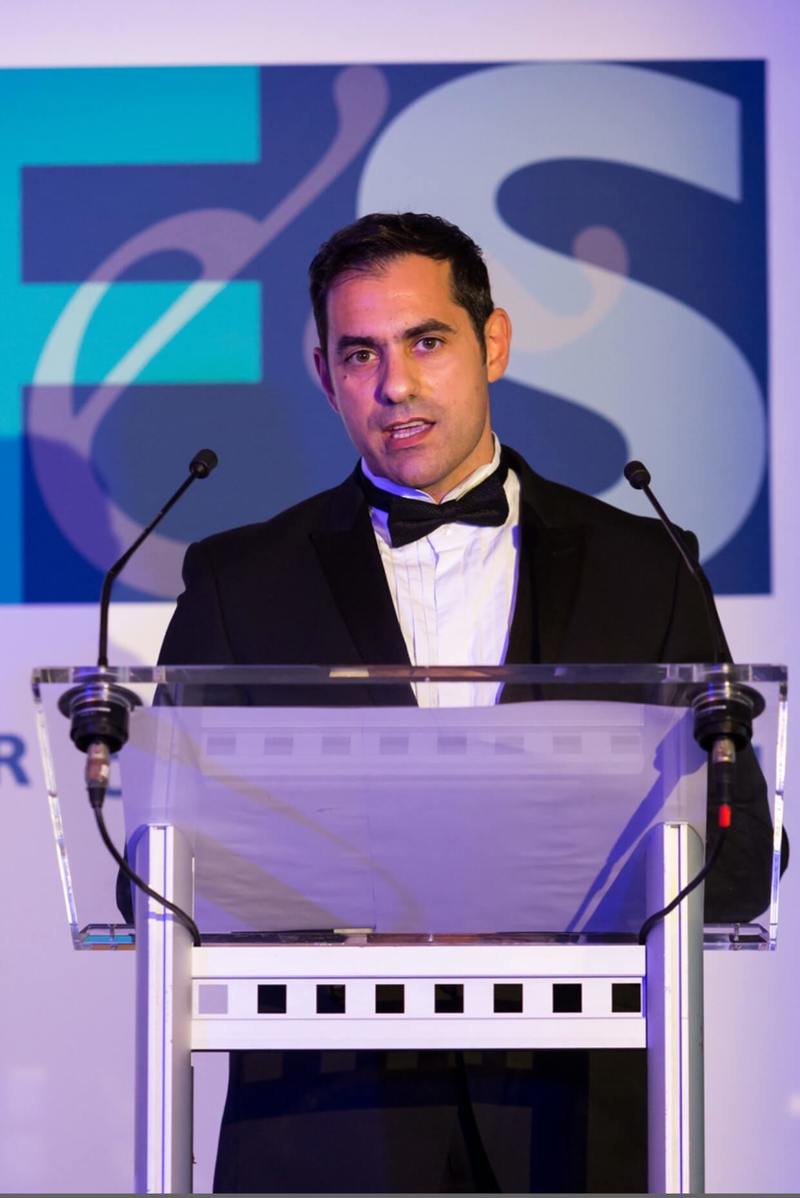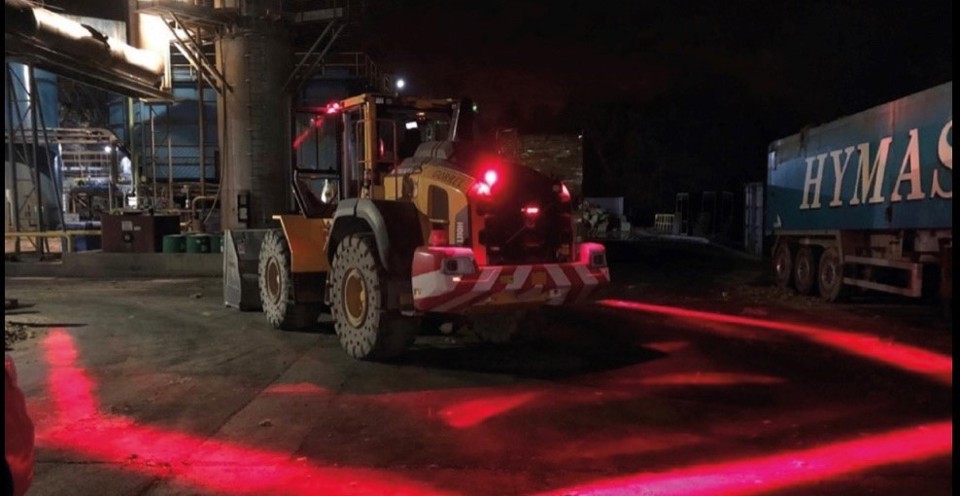A need to illuminate bouncers working in the dark at a chain of family-owned nightclubs became the catalyst for a range of innovative safety products that are saving lives by protecting staff working in the vicinity of vehicles.
Andrew Kimitri realised his creation, which consisted of illuminated uniform strips, could have uses in other industries. He first approached the railway industry with a “really crude Hi-Viz vest with LED strips stitched to them and some batteries”.
The response was overwhelmingly positive; but it was still essentially a concept.
It was the start of a five-year journey to produce a garment that fused electrical components into material that would need to be waterproof and wash proof to meet EN standards.
The result was the Contego vest, an orange garment with an illuminated light strip between the prismatic reflective material tape. This meant it would illuminate in its own right, not just under a light source.
Launched in 2010 under the company name FHOSS (the Greek word for light), it quickly became established as the elite safety product for the railway, with Kimitri extending the range into vests, jackets and trousers.
However, it was also expensive compared to standard Hi-Viz clothing which enabled companies to box tick for less than a quarter of the price.
Undeterred, Kimitri continued to look at ways to innovate and diversify the proposition, working with his Chinese partners who build the products.
“We were selling hundreds of these things, but we couldn't be what we wanted to be,” said the CEO. “So we looked at the industry and started coming out with new ideas.”
Illuminating highway vehicles at night
The first step was self-illuminating chapter 8 vehicle livery, for example chevrons on the back of a van.
Called Light Livery, it uses a paste-based phosphor technology called electroluminescence. FHOSS runs a current through the material to power it. Not only does it illuminate in the dark, it can also flash, making it ideal for highway maintenance vehicles.
However, the breakthrough was Halo in 2018, a visual exclusion zone around large plant which casts a solid red line around the vehicle to show the danger area for those working nearby.
“That became a really big seller straight away because you're now selling a piece of kit fitted for £1,500 on a £400,000 vehicle,” Kimitri said.
He added: “And then we started further developing because what we're really good at is understanding our client base and working with them to understand their needs and their pains.”
This led to the creation of the FHOSS Walkway, a safe passage for people to cross a busy thoroughfare at sites such as quarries where hundreds of vehicles, such as massive dumper trucks, pass each day.
The system, which is manufactured in the UK, is like a mobile pelican crossing. The worker presses a button which illuminates the safe route while traffic lights stop the vehicle. Then the gate is unlocked, and the worker safely crosses the road.
The potential savings are huge. As Kimitri says “how much do you put on a life?”, but there are also directly measurable cost reductions.
For example, a site with four or five crossing points would each have at least one marshall, sometimes two, on a minimum of £25,000 a year doing a nine-to-five job, six days a week. Some sites are even open 24/7.
They would also have welfare vans for breaks, subsistence and toilet facilities, adding extra costs.
All those costs can be removed by investing in the £9,000 Walkway solution.
“It's truly cost effective for businesses,” Kimitri (pictured below) said. “And the one main thing really is that it's all about trying to improve behaviour to make the workforce feel safer.”

A ‘World of Safety’
Kimitri was starting to build a FHOSS “world of safety”, but one key element was missing: his products were designed to illuminate in the dark. But what about daytime?
He had noticed a surge in sales during the winter months, with longer nighttime hours, but demand dried up in summertime.
However, risk was present year-round.
“We wanted to create a product that would work 24/7 so that we could be selling it all year and from a customer's experience he knows that that system works day and night,” Kimitri said.
“So we went back to the drawing board and spent a lot of time looking at how we could make something that would work during the day.”
That “something” was the FHOSS Field, essentially an invisible forcefield surrounding the vehicle that triggers an alert to the driver if breached.
Launched in 2022, FHOSS Field uses AI technology and cameras to set an exclusion zone around the vehicle with algorithms taught to detect human presence based on arms, hands, feet clothing, hard hats and so on. It also includes the Halo visual red line for additional safeguarding.
If there is an infringement, the system sends a verbal message to the operator. Kimitri rejected flashing lights and bleeps because a crucial aspect is ensuring the operator instantly understands and takes immediate action.
“We created these audible speakers which say ‘caution - pedestrians detected’ or you can have that message be anything you wish,” he explained.
“You can even go to ‘pedestrian detected left’ or ‘pedestrian detected right rear left, rear right’ and so on. The cameras are extremely accurate, about 92%. So there's minimal false detection.”
FHOSS Field, which starts at around £3,000, also captures data and can notify the fleet manager when there has been an infringement so they can view the footage.
The system can also be used to monitor Walkway crossing points to ensure workers are walking within the correct zone. If they step outside, it’s a safety violation.
Kimitri added: “If you were to walk across outside of the zone and a vehicle hits you, that's an extremely different position in terms of insurance risk, whose fault it was, because you're outside of the actual crossing.”
Many companies using the forcefield system are benefiting from an insurance bursary, according to Kimitri, where brokers help to fund the kit and reduce their premiums after assessing risk over a certain period time.
Speedy Hire has been a vociferous advocate for FHOSS Field since its launch. In the past 12 months, it has been fitted to more than 500 Speedy vehicles, typically beavertail, flatbeds and high side vehicles which are offloading kit while the driver is operating the vehicle from one side.
“It's extremely difficult to see what’s on the other side,” Kimitri said. “If a cyclist goes past, it will tell the operator on the other side that there’s a pedestrian in the zone.”
The system also helps to eliminate reversing incidents which blight many fleets and is also ideal for protecting people working around loading bays.
FHOSS’s latest innovation is Cast, which projects messages onto walls or floors. It eliminates the costly expense of painting – and regularly repainting - warnings or instructions onto the surface. One customer, Amazon, was spending £250,000 a year on floor markings at its Leicester site to separate people from assets. Now it simply casts illuminated messages.
“We can even project a zebra crossing point, with 22 projectors and bulbs that last 90,000 hours,” Kimitri said. “Once you put them up, they last for years, there's no maintenance.”
Video
Powered lighting options
FHOSS’s products are battery-powered or run from either the vehicle or the mains. Some sites are also powering Walkway on solar and hydra cells.
A growing number of major fleets have invested in FHOSS, including Balfour Beatty, BT, Skanska, Cenex, Tarmac and Kier. Target industries include construction, haulage, waste management and warehousing, while products are being fitted to everything from car-derived vans – which typically use one rear camera and a lower cost version of Halo called Arclight which projects a half-moon exclusions zone - to huge loaders.
“One of the questions we ask is ‘do your employees come in close contact with vehicles?’. 100 out of 100 say yes,” added Kimitri.
Ultimately, how effective are FHOSS products at reducing – or even removing – risk?
“I'll bite my tongue very hard when I say this, because you never know, but since we've been selling our products, we've not had one incident,” Kimitri said.
He added: “From the feedback we get from customers, it's making a huge benefit to their safety. The behaviour of employees is also improving in terms of their ethos to go to work and get home safely because companies are investing in them, by investing in the equipment.
“There is positive feedback from director level to management level, which is great, but we also love to hear what the boots on the ground are saying and how can we improve.”
Kimitri’s vision of a “FHOSS World” is getting closer by bringing together his product range and adding the data insights.
“People want data. We consistently want to understand ‘what's the behaviour of my staff? What's the behaviour of my vehicle? What's the pattern of that vehicle?’,” he said.
“We’ve got some real clever ways of capturing key data that we believe will really improve the work environment, improve safety and reduce cost.”
For more ways to improve safety and protect your emplpoyees, read our best practice report on Running a Safe Fleet.





















Login to comment
Comments
No comments have been made yet.